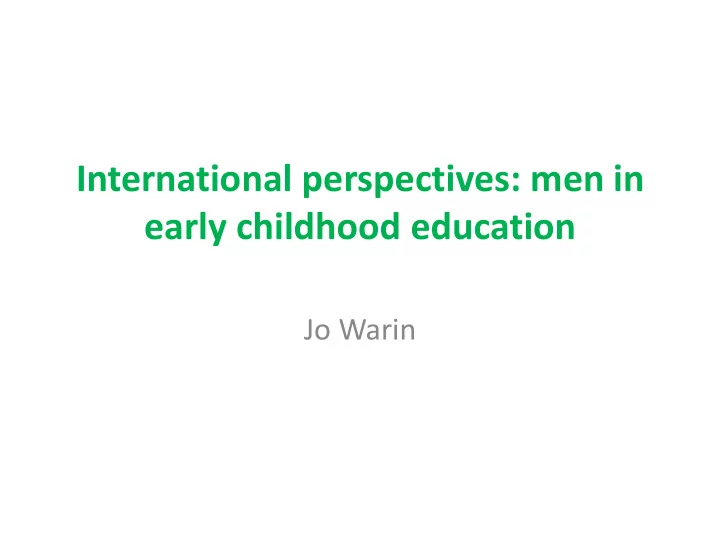

International perspectives: men in early childhood education Jo Warin
Who I am • Broad interests in gender and education • Family gender roles especially Fathering • Men in Early Childhood Education (ECE) • International Network on Gender, Teaching and Care – with focus on men in ECE
INTERNATIONAL PERSPECTIVES ON GENDER AND CARE IN ECE
Purposes • To recognise and give status to the highly skilled and demanding nature of professional work in ECE • To transform gender by dismantling damaging gender stereotypes SO: • To recruit and retain more male teachers in the early years education workforce
What can we learn from other countries? Are there other countries who manage the recruitment and the retention of men better than we do? Can we copy what they do? Sweden ( and other Scandinavian countries) Indonesia Japan USA
Recruitment and retention of men in ECE across the globe? The general pattern of presence of men in ECE : Less than 3% (Brody, 2013). In the Nordic countries - famed for gender equality Norway: 9 % (Statistics Norway, 2014) Iceland: 7 % (Statistics Iceland, 2014) Sweden: 4 %(Statistics Sweden, 2014) Denmark: 8% (in 2007)* Finland: less than 2% (in 2008)* *Denmark and Finland do not publish stats on workforce gender so figures are from Baagøe Nielsen, 2011,
Swedish preschool
Findings from interviews in Sweden Male ECE workers were familiar with Sweden’s national curriculum (equivalent to the FS) which states that ‘The preschool should counteract traditional gender patterns and gender roles’ ( Skolverket, 2011, p. 4)
Pre-service training They were attuned to gender issues and some had been trained to develop gender sensitivity. They described how they performed non-traditional, gender flexible practices in front of their ‘audience’ of children. E.G.: Karl told me that he believed it was important that the children should witness him changing the diapers of the infants in his care Linus was deliberate in his intentions to have the children witness his laying of the table before the midday meal: “ They see me laying the table and doing everything that women teachers do’
Complementary roles especially in play They also said that men bring something specifically masculine and complementary to early childhood education: humour, playfulness and freedom. For example, the role of the male teacher was described as • ‘ Popular. Like a pop star swooping in’ (Per) and • “ It’s easy to be a man –because ‘ oooh ’, the kids like you ” (Linus) • “ I like to play with them. I’m a fun guy….children can feel I’m a playful person. I’m not a strict person ” (Jonas) • “I more often see men playing. I more often see female teachers saying ‘have you washed your hands ?” ( Geir)
Findings from interviews: Indonesia The male ECE trainees expressed: • A pioneering zeal and they felt that the government should be putting more money into the recruitment of men. • Ambition re careers. They wanted to work their way through classroom teaching to managerial positions and perhaps to teacher training • The influence of their religious and cultural context of early childhood education. Beliefs about what is ‘natural’ for men’s and women’s adult roles, compatible with mothering and fathering, and an antipathy to homosexuality
Japan and USA The ‘gender neutral’ professional was emphasised in Japanese case study. Gender is embedded in Japanese language and it is a stretch for male teachers to talk ‘softly’ USA case study shows women and men teachers positioning the role of the male early childhood educator as a tough disciplinarian and ‘a big manly guy ’. ‘Troops to teachers’
Take home messages The recruitment and retention of men is inextricably linked to other social policies. Countries with more men in ECE also have parental leave policies and a whole infrastructure of gender egalitarian policies. BUT Gender sensitivity training in pre-service programmes Creative recruitment strategies – in secondary school
Recruitment planning at University West, Sweden Stimulated by Norwegian recruitment ads: Er du var nye mann (Are you our new man?) and Menn I barnehagen (Men in the nursery) http://www.youtube.com/watch?v=cRsLEAlK8Wc http://www.youtube.com/watch?v=SiAlTAdvDUk http://www.youtube.com/watch?v=ITni4zOISaQ Strategies: • Visits to secondary schools with lectures inspiring preschool work – for boys and girls • Secondary school students shadowing preschool staff
Some questions we might consider • Why is the gender pattern of work in early childhood education so resistant to change? • How can we rescue the ‘missing men’ agenda from a pre - occupation with men as ‘ male ’ role (with implications for entrenching gender differences) • How can we reframe and promote this agenda as the all- important need to have adults, both men and women, who can perform in gender flexible and fluid ways to their young audiences? • How can we train male and female pre-school staff to model gender flexible behaviors in front of children and their parents?
Recommend
More recommend